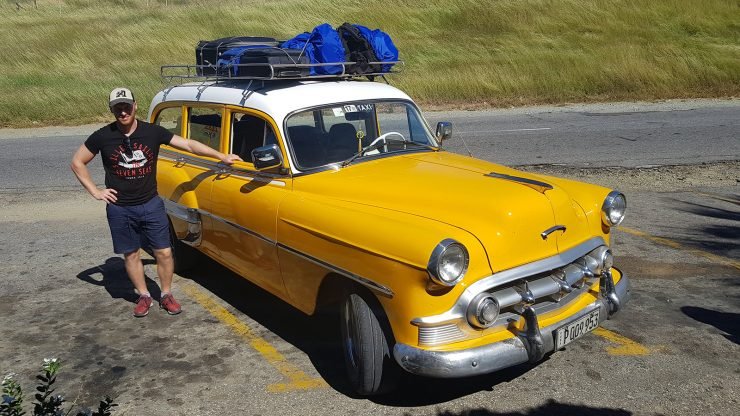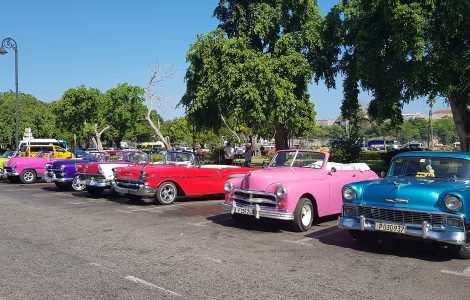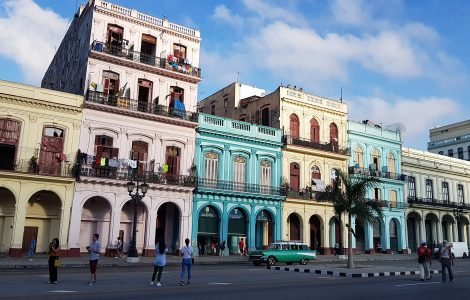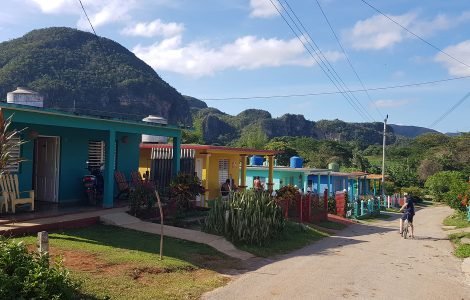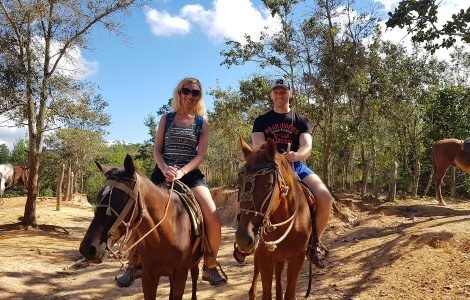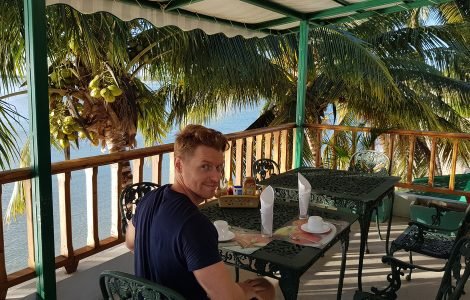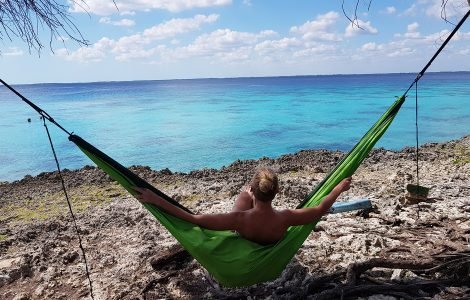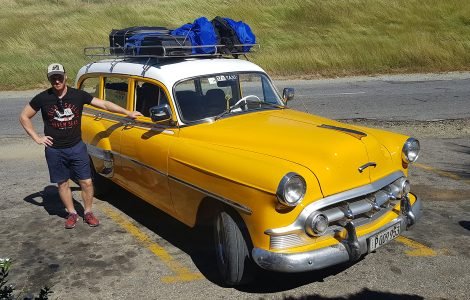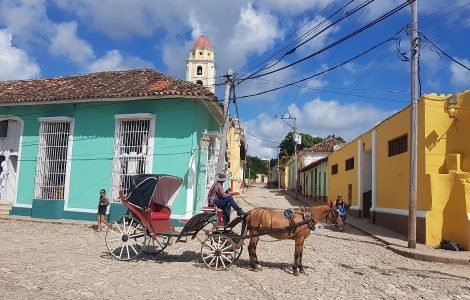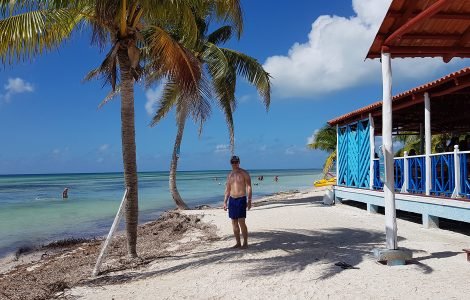In 2017 we enjoyed the opportunity of travelling in Indonesia where most of the time we spent in Bali. After that trip together with my girlfriend, we decided to try something completely new, so we took a map, put a finger on the opposite side of the world and Cuba became our next destination. We had heard little about it, so we did a short research on the internet to gain an insight into what there is to see there. Excellent Caribbean climate, palms, beautiful beaches, old-style cars, mountains, Latin music and cocktails seemed perfect to us, so we started planning the trip.
Preparation (time to travel, ticket prices, visas)
As always, the first thing to decide is the time to travel. The most favourable time to go to Cuba is between November and March because usually at this time the weather is very warm (around 30 degrees Celsius in the daytime) and the hurricane season is over so it rains little. We decided to go at the end of October and we didn’t regret it because it was very warm and absolutely no rain. Leaving from Lithuania we were able to choose the flight with one or two stopovers. Although the flight with one-stop was shorter, it was much more expensive, so we decided to take the flight with two stops at the price of 715 EUR per person for a return ticket. Usually, when travelling long-haul with stops we attempt to have stopovers of 7-12 hours so that we could visit the surrounding areas. In our case, the flight stopped over in Frankfurt and Toronto, and in both of them, we had enough time to get out to the city, look around shortly and have a meal there. By the way, in case of passing Canada, be sure to fill in the ETA (Electronic Travel Authorization) form, which costs about 7 dollars and is valid for 5 years. This form is bound to your passport, so the officers at the border check will see if you have filled it or not. In addition, when entering Cuba, a special Cuba card is requested, which costs 30 EUR in Lithuania. We had purchased it, though landing in Havana we were given it for free on the plane (probably it depends on the airline and we were simply lucky). During the trip, we noticed a lot of tourists carrying Lonely Planet guide for Cuba with them, but we managed pretty well without it as we got all the relevant information from the tourist information centres and Casa owners who hosted us. It is also worth having a power plug adapter as electricity sockets in Cuba are different from the European ones and it might cause additional inconvenience. We didn’t have one so we had to charge our phones at the restaurants or to borrow chargers from other people.
Accommodation (Casa particular and hotels)
We found out that in Cuba it is very easy and worthwhile to arrange a private homestay with local people, it can be done straight away on the street. Besides, there are considerably fewer hotels in Cuba and they are rather expensive, meanwhile the sign “Casa particular” hangs on every house which has rooms to rent. Usually, it is a separate tidy room with private bathroom in a house or in an apartment. You come inside and ask if there are rooms available or not. In our case, usually, there were, and if not, then the landlord would arrange a room at neighbours’ because Cubans care about one another very much. The price of the room rent in Casa is about the same everywhere, i.e. 20-35 CUC (approximately 20-35 euros) for the whole room which usually contains two beds (double and single). So, it is worthwhile to travel in groups of three, plus there are chances to find rooms with more beds. We gave up the idea of staying in hotels because we were eager to stay with local people and it worked out very well for us. Casa owners who spoke English told us about life in Cuba, which is actually hard, gave us valuable advice for planning further trip and excursions, arranged accommodation for us in other cities when we wanted it, and ordered us taxi Colectivo that would take us directly from the house. All these tips of Casa owners helped us save quite some money. We booked Casa through booking.com only for the beginning of the trip as we were arriving to Havana very late in the night. Then the Casa owner also arranged a taxi to take us from the airport and bring us to the Casa, so we didn’t need to worry about transportation. By the way, a taxi ride from the airport to Havana city usually costs 25 CUC. For all the other nights we found the accommodation on the spot (other travellers we met were also using AirBnB quite often). And the only case when we opted for a hotel was the last three days that we spent in the resort town of Varadero, where we took an all-inclusive offer because Varadero has a great variety of hotels and it is possible to find a really decent one at an affordable price.
Transportation
There are plenty of different ways to travel within Cuba – one can use local flights, drive a rented car, use public buses, taxis or shared taxis (taxi Colectivo) – so we will discuss briefly each of these options.
Local flights. Cuba is an elongated island, so to travel around all of it, the best option would be using domestic flights. Although this way of travelling is quite expensive, it allows to go all over the island in a relatively short period of time and to visit all the popular sights. Generally, the distances between bigger cities are rather long, thus travelling by car or bus takes quite much time. To save time, but not money, this would be your best choice.
Renting a car. This would be the best option when travelling with young children or a bigger family. It is possible to rent a newish car and to travel independently. Driving is relatively easy as long-distance roads are paved and half-empty, sometimes you wouldn’t see a car in quite some kilometres. The cities are usually free of traffic jams too. It is best to arrange car rental in advance, through a travel agency in the country from which you are coming. This way of travelling is not cheap but offers great flexibility. Basically, you are absolutely independent. Anyway, as we heard, the supply of the cars is limited, probably that’s why the prices aren’t that low.
Buses. Quite some buses are riding between the cities, most of them are pretty new and neat with air conditioning and even toilets. This way of travelling has its pros and cons. Infrequent cases, it is a cheap way to travel, but when buying a ticket on the same day when you want to leave, there is a chance that no places are available anymore, so you will have to re-plan the trip and go another day or by another transport. It is best to buy a bus ticket 1 or 2 days prior to departure, then you can be sure that there are available seats. Travelling by bus takes quite much time because they don’t go fast and often stopover in between to rest or to let the passengers out. But on a hot day, it is very convenient due to comfortable seats and air conditioning.
Taxi. You can hire a private taxi, which would take you to the nearest town or an attraction. It won’t be very cheap, but you will travel comfortably and won’t need to adapt to anyone else.
Shared taxi (taxi Colectivo). It is the most popular way of travelling between backpackers and other individual travellers or groups of them. It is cheap and you travel with various people from different countries of the world, with whom you can share experiences and useful advice and simply have fun on the road. In every town, almost on every corner, you will find Cubans offering shared taxi services, plus, there is space for bargaining. Shared taxis are kind of minibuses that might take from 4 to 16 people and the transport itself is very diverse, from old style American cars to pretty new vehicles with air conditioning. The drivers collect passengers from home and let them out wherever they desire. If you are travelling with a group of 16 people, then collecting and dropping off the passengers will take quite some time. In addition, when travelling this way longer distances there is a high chance that you will be re-seated to another shared taxi, but in conclusion, this option is working very well all over the island, so we highly recommend using it.
Food
Unfortunately, most of the Cubans are not good at cooking. It’s hard to explain why, but food in local restaurants and eateries more often than not is tasteless. It seems they are trying to copy something, but they keep getting it wrong. For example, in one restaurant we ordered pizza, but the pizza base tasted more like a pancake, so instead of pizza, we ate crêpes. After various experiments, our tips regarding food would be as follows. We suggest ordering breakfast at the place of staying at all times because most of the cafes and restaurants open only at midday, and it is hard to find a food shop plus their assortment is very limited. In every casa the breakfast is more or less the same and quite filling. Usually, you are served eggs, buns, butter, cheese, boiled ham, fruit, juice, tea and coffee which is very tasty in whole Cuba. In some places, crêpes with jam are served or a piece of cake is added alongside the coffee. If you decide to go to a restaurant for lunch or dinner, we recommend choosing a western one with many tourists, the food there will definitely be tastier. Don’t doubt queuing for the better restaurants – the queue there is standing for a reason. We recommend ordering meals of seafood. Even though quite often they are overcooked, they are still delicious. All lobsters and seafood paellas which we ate were delicious. You can also order pasta and spaghetti, we ate them more than once and everywhere they were delicious.
Drinks
Since it is quite hot in Cuba, you will definitely want to drink. Tap water is not potable, so everywhere bottled water must be bought. Usually, water bottles are sold in casas or in any shop or kiosk. As for alcohol, rum is very cheap. 0,7 l bottle of Havana Club costs from 4 CUC (3,6 EUR) and can be bought at every corner. The choice of beer is narrow, maybe there are some three types of it, two of which are local beers and in the restaurants, 2-3 CUC are charged for 0,35 l can or bottle. Rum cocktails can be ordered at every restaurant or cafe, their prices vary from 1 to 3 CUC (0,9 – 2,7 EUR), and in many places, they are offered right on the street, at the entrance of some restaurant. Cubans themselves are passionate fans of rum.
Currency
Two types of currencies are used in Cuba – CUP (Cuban peso) and CUC (Cuban convertible peso). CUC is intended for tourists only, and 1 CUC is about 0,91 EUR. CUP is intended only for local residents, 25 CUP equals to 1 CUC. Local people use it to buy food in markets and specialized shops or to pay for some small services such as haircuts or so. It is hard for tourists to get CUP currency as normally it is not traded in currency exchange offices. There is an impression that only the locals are able to get it though only small items can be bought using it. This currency is useful for poor Cubans. The two currencies are easy to distinguish – all CUC banknotes have images of monuments on them and all CUP banknotes carry images of famous people. Once you land at Havana it is best to exchange money at the airport exchange office. It is recommendable to carry euros with you and to avoid US dollars as it is subject to an additional 10% tax. Payments by cards are available nearly nowhere but all larger cities have ATMs where you can withdraw money. We did it more than once using a credit card of our bank, though Revolut card did not work. Withdrawing money should be no worry. Try to withdraw low-value notes, because many places do not have change from banknotes of higher value. We recommend having some small change with you at all times as in many places you’ll be asked to pay for a toilet (even in the restaurant where you eat), plus, live music is playing in many restaurants and you are supposed to pay for it separately, and in many places, you’ll be asked for some tips.
Safety
Cuba is very safe, the crime level is low, you will see police officers patrolling in many places. You can peacefully walk down the streets in the evenings. Local people approach frequently offering taxi services, fake cigars or accommodation, but they aren’t aggressive, only might be a little annoying at some times. We didn’t see drunk people anywhere. Although locals drink quite some rum, it seems they don’t go over the limit. Cubans themselves are very positive people, they help one another a lot and always assist tourists as they understand that tourism is protecting their country from poverty. More than once we saw young families travelling in Cuba, so a trip with a kid of 1 or 2 years is definitely feasible.
Internet
When we were in Cuba, the internet for tourists was available only in specified wi-fi zones usually established in city squares or in restaurants. It was possible to connect to the network only upon buying a connection password, which illegal sellers were offering at a more expensive rate at the access points. Normally, the passwords are obtained at the shops, hotels or at the client centres of mobile service providers. The charge for 1 hour is 1-1,15 CUC. So, during the trip we were basically without internet, connecting to it only on rare occasions. As we knew about this before going to Cuba, we had downloaded to our phones “Maps.me” app that functions without internet, and it was perfect for us. The navigation worked flawlessly, it helped us to find all the attraction spots, gave recommendations for restaurants and accommodation sites and enabled to orient us around. It would have been much harder without this app. Additionally, on our phones, we had a few English-Spanish dictionaries that do not require the internet. These dictionaries proved to be useful in dealing with locals, who did not speak English and there were quite many of them. By the way, while writing this article I learnt that from 6th of December, 2018, Cuba government is to allow the locals to have unlimited internet on their phones.
Attractions
Once in Cuba, it is worth spending a few days in the capital city – Havana. There is a beautiful beach near it which can be reached by public bus. After that, it is a good idea to visit Vinales town surrounded by scenic mountains and tobacco plantations. It is possible to go diving or snorkelling in the Bay of Pigs. Trinidad city stands out for its colours, sugar cane plantations, beautiful beaches and mountains. Cienfuegos city boasts exceptional neoclassical style architecture. The last few days are worthwhile to be spent at a beach hotel in the resort town of Varadero which is situated on the Hicacos Peninsula renowned for its extraordinary beauty. Some of the American and Canadian tourists come here for the twentieth time, they like it so much. All the cities of Cuba are diverse and interesting. We spent 15 days in Cuba and we managed to travel only half of the island, 6 cities in total. We are sure that in a month it is possible to travel through the entire island. Around the main island, there are many kinds of smaller islands, which are also worth a visit, but it would require some extra time.
Is it worth going to Cuba?
Absolutely yes, though from a few people we have heard comments that there are too many tourists there already. During our trip, there were quite a few tourists but only at the most popular sights. In other places, there were less of them and personally, to me, they were no nuisance. If you plan your trip at the beginning or at the end of the season, certainly you will not be disappointed. Cuba is a unique and colourful country, which fleeing from poverty goes towards tourism, so tourists are and will be very welcome there, and they’re really are great things to see.

